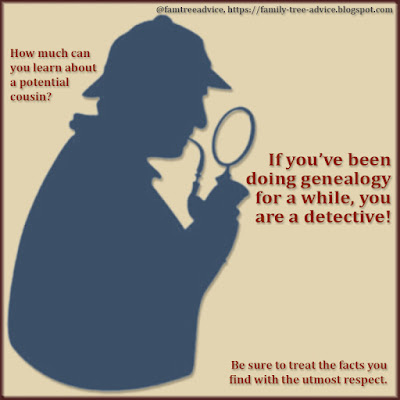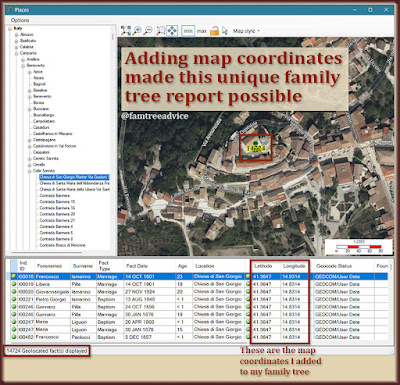Sometimes my innocent genealogy detective work scares me. Using detective skills is an important part of genealogy research. We're always trying to find a family connection, or searching for important documents.
Many times we need to investigate living people. And that feels a lot like stalking. Our intentions are pure—we just want to figure out that connection! But it can get creepy when you realize how much you can learn.
This weekend I found myself looking once again at the DNA matches my parents have in common. One person in particular, let's call him JS, intrigued me. I always thought his face looked familiar. He looks like he could be my cousin.
When looking at my mom's DNA test, JS is her 4th–6th cousin on her paternal side. And I know her paternal side has its roots only in one town: Baselice, Italy. JS doesn't show up in my dad's DNA match list, but Mom and JS's shared matches are another story. They have 3 shared matches, not counting me:
- WL is the descendant of my 3rd cousin 3 times removed, Donato Zerrillo. Donato came from my father's ancestral hometown of Colle Sannita. According to AncestryDNA, WL is my mom's 4th–6th cousin as well as my dad's, and mine, too!
- MN has no family tree on Ancestry. AncestryDNA says he my mom's 4th–6th cousin, but he shows up as my dad's 2nd–3rd cousin and my 3rd–4th cousin.
- PD is someone I've contacted before, but we can't figure out his connection to my mother. He has a possible Leone in his tree (my primary name from Baselice), but the connection isn't verified. The surprise is he has close ancestors from Dad's Colle Sannita. AncestryDNA says he is my mom's, my dad's, and my 4th–6th cousin, and I have the paper trail that says he's my dad's 4th cousin.
This brings me back to JS, the match who has a connection to all the people listed above. You can see the ethnicity estimates of your DNA matches. This tells me that JS has 23% Italian ethnicity and the rest is Germanic and Ireland. He should have an Italian grandparent or a couple of Italian great grandparents.
Since he has no tree on Ancestry, I began my detective work. I searched Ancestry for his name and found some public record indexes. These told me he had lived in 3 different U.S. states and that he's my age. I found his father's obituary easily. This told me JS's parents' names, his 2 uncles' names, and his 2 siblings' names as well as a sister-in-law. I found JS's father's family in several U.S. censuses and other documents. Then I found an Ancestry tree clearly owned by JS's sister-in-law.
 |
| If you know a lot about your DNA match, you just might be a detective. |
I looked on Facebook and found JS using the same profile photo he uses on Ancestry (bless him for that!). I found his siblings, sister-in-law, and a cousin or two. But the main thing I noticed on Facebook and in the tree his sister-in-law built: ZERO Italian names. (And I'm only Italian.)
I now know which names provide JS's Germanic and Irish ancestry. But where is that 23% Italian hiding? The family tree of "S" ancestors goes back several generations, and all the names look German or Irish.
My only thought was Northern Italy. JS's ethnicity was 13% Southern Italian and 10% Northern Italian. What if one of his Germanic names was from the part of Italy that's so close to Switzerland that the lines blur? There are families in this part of Italy with Germanic names. I used to work for one; it was shocking to find out he was Italian.
I used an old favorite trick of mine to see which of JS's family names might be from Italy. I went to Ancestry and searched for passenger lists with only that last name. Then I looked at where people with the name came from.
I started with JS's own last name—a German-sounding name. I found a small number of people from Switzerland with that name. Ah, but a draft registration card told me JS's grandfather was born in New York City. I'd have to track down his ancestors. I discovered that even JS's "S" great grandfather was born in New York to parents who were born in New York. It's time to try another branch of JS's family tree. But his sister-in-law's family tree shows the mother's family was born in Germany. And his father's mother's family all came from Ireland!
While trying to figure out what to do next, I returned to the search results for JS's grandfather's name. I clicked a German birth and baptism record. It listed a birth place of Hirschthal and I thought, go ahead—see where that is. It turns out to be in Switzerland, but much further from Italy that I'd hoped.
Still, I may as well step out a bit further on this limb. I went to the Cognomix website where you can check for the location of family names throughout Italy. I put in JS's last name. The numbers are small, but that Germanic name does exist in Northern and Central Italy. But now I'm too far up in JS's family tree to account for his 23% Italian ancestry.
His DNA connection to my mom and me, and his connection to my dad's connections, has me so curious. I'm going to write to him on both Ancestry and Facebook and hope for the clue I need. Of course I can't mention all I've learned about him. I made that mistake once and scared off an interesting DNA match forever! I'll lead with "Who are our shared Italian ancestors?" That sounds both specific and un-stalkerlike.
Have you discovered more than you ever imagined about a potential cousin? Does it worry you? Try searching for yourself in various places. I searched Bing.com for myself under my maiden name. I found tons of these blog articles, photos I uploaded to memorial pages, and my comments about genealogy. On Ancestry, nothing came up, even though I know there's an index for my first marriage on there—that came up when I searched on Google.com. My favorite discovery is seeing all the times someone mentioned this blog that I never knew about.
How has genealogy improved your detective skills? Remember to always be a benevolent detective with genealogy as your only goal.
And speaking of DNA matches:




